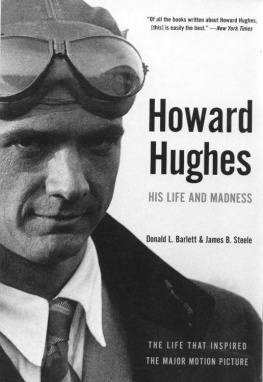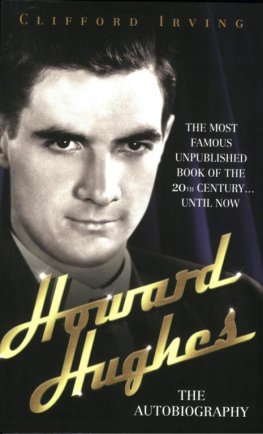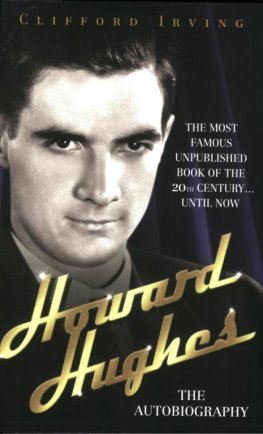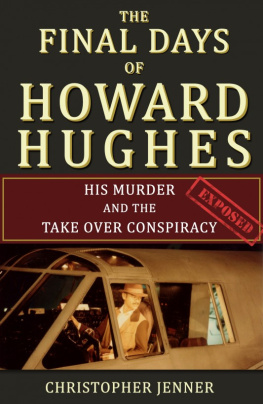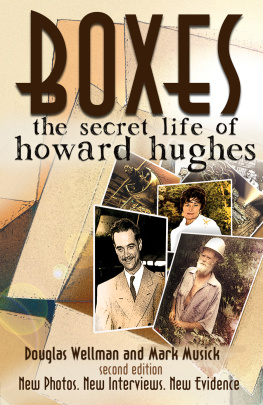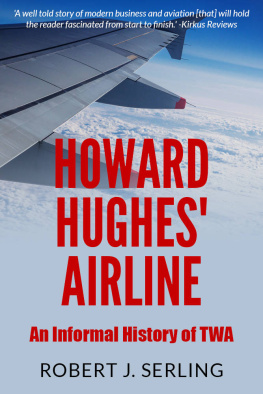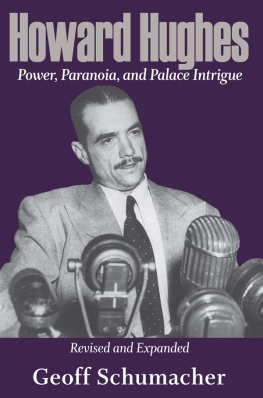By Donald L. Barlett and James B. Steele
Copyright 1979 by Donald L. Barlett and James B. Steele
Citations from I Remember Howard Hughes by Dore Schary, 1976 by the New York Times Company. Reprinted by permission. Citations from Howard HughesRecord Breaker by Rupert Hughes 1937 by Macfadden Publications, Inc. Reprinted by permission of Liberty Library Corp. Citations from CIA Reportedly Contracted With Hughes in Effort to Raise Sunken Soviet A-Sub by William Farr and Jerry Cohen, Copyright 1975 by the Los Angeles Times . Reprinted by permission. Citations from Hughes Buys More than 500 Silver, Gold Claims in Nevada by Arelo Sederberg, Copyright 1969 by the Los Angeles Times . Reprinted by permission. Citations from Spry Miner, 96, Waited 60 Years for Silver Boom by Charles Hillinger, Copyright 1969 by the Los Angeles Times . Reprinted by permission.
Manufacturing by The Haddon Craftsmen, Inc.
Barlett, Donald L. [Empire]
Howard Hughes: his life and madness / Donald L. Barlett and James B. Steele.
p. cm.
Originally published as: Empire. 1 st ed. c1979.
Includes bibliographical references
ISBN 9780393326024
1. Hughes, Howard, 1905-1976. 2. CelebritiesUnited StatesBiography.
3. BusinesspeopleUnited StatesBiography. 4. MillionairesUnited StatesBiography.
1. Steele, James B. II. Title.
CT275.H6678B37 2004
338.767092dc22
[B] 2004050138
W. W. Norton & Company, Inc.
500 Fifth Avenue, New York, N.Y. 10110
www.wwnorton.com
W. W. Norton & Company Ltd.
Castle House, 75/76 Wells Street, London WIT 3QT
PREFACE
F EW , if any, figures in American history have provoked so many suspicions, stirred so much curiosity, inspired so many images, and been so greatly misunderstood as Howard Robard Hughes, Jr.
Such was the mystery and power surrounding his life that when he was pronounced dead on arrival at Methodist Hospital in Houston, Texas, on April 5, 1976, his fingerprints were lifted by a technician from the Harris County Medical Examiners Office and forwarded to the Federal Bureau of Investigation in Washington. Secretary of the Treasury William E. Simon, for federal tax purposes, wanted to be sure that the dead man was indeed Howard Hughes. After comparing the fingerprints with those taken from Hughes in 1942, the FBI confirmed the identity.
The public life of Hughes was itself enough to ensure the spinning of a certain mythology. He was a record-setting aviator cut from a heroic mold on the Lindbergh model. His amorous adventures with some of Hollywoods leading ladies and his eccentric lifestyle were the stuff that sold newspapers. His fabulous wealth and his reputed genius at the business of making evergreater amounts of money only heightened public curiosity.
As the years wore on, Hughes became in the public mind what his public-relations apparatus wanted him to be. In this, the publicists did not lack assistance. All who had known Hughes, and many who only claimed to, had a story to tell about the reclusive industrialist. And so the legend grew, embroidered, indeed made possible by Hughess pathological obsession with secrecy and seclusion.
So completely was truth distorted that Hughes could lose tens of millions of dollars for more than thirty consecutive years in one of his companies and yet be named one of Americas ten greatest businessmen. So impenetrable was the curtain of secrecy that Jean Peters, invariably pictured as a deeply involved Mrs. Howard Hughes, only saw her husband by appointment.
So it is that any serious biography of Howard Hughes must surmount and remold the legend given currency, and all but petrified, by years of repetition. This task is both aided and impeded by the size of the public record, which runs to hundreds of thousands of pages of documents relating to Hughes and his empire. It is clear to the authors, after four years of research, that the record spawned by Hughes is rivaled in size by few men of modern times. Because this material is not found in any central location, but rather is scattered from coast to coast, only bits and pieces have found their way into the public print. As a result, the full story has gone untold. Spanning the whole of Hughess life, we have compiled the single largest collection of Hughes documents and records outside the Hughes organization itself, the largest and most powerful privately controlled business empire in the country. We examined more than a quarter-million pages of records and documents, from which we reproduced, or in some instances handcopied, some fifty thousand pages. The material was gathered from sources in more than fifty cities in twenty-three states and five foreign countries, from Bayonne, New Jersey, to Santa Ana, California, from Nassau to Tokyo. The papers were drawn from nearly fifty different offices, agencies, and departments of local, state, and federal governments, from the Los Angeles Police Department to the Department of Defense, from the Nevada Gaming Commission to the Quebec Securities Commission.
These papers include thousands of Hughess handwritten and dictated memoranda, family letters, CIA memoranda, FBI reports, contracts with nearly a dozen departments and agencies of the federal government, loan agreements, hundreds of memoranda and reports prepared by Hughes executives and lawyers, deeds, mortgages, lease agreements, corporate charters, census reports, college records, federal income-tax returns, Oral History transcripts, partnership agreements, autopsy reports, birth and death records, marriage license applications, divorce records, naturalization petitions, bankruptcy records, corporation annual reports, stock offering circulars, real estate assessment records, notary public commissions, applications for pilot certificates, powers of attorney, minutes of the board meetings of Hughess companies, police records, transcripts of Securities and Exchange Commission proceedings, genealogical records, government audit reports, voter registration records, annual assessment work affidavits, transcripts of Civil Aeronautics Board proceedings, the daily logs of Hughess activities, hearings and reports of committees of the House of Representatives and Senate, transcripts of Federal Communications Commission proceedings, wills, estate records, grand jury testimony, trial transcripts, civil and criminal court records.
None of this is to suggest that all information appearing in an official government document or legal record is the whole truth. Obviously, such is not the case. Long before Clifford Irving appeared with his spurious autobiography of Hughes, forged documents, although uncommon, were not unknown in the Hughes empire. A fake memorandum bearing Hughess name, submitted to McGraw-Hill by Irving as evidence of the authenticity of his manuscript, was not the firstor lasttime that Hughess signature was forged. Nor was it the last time that someone prepared a bogus Hughes memorandum. Moreover, thousands of critical documents once in the possession of the Hughes organization have been destroyed as no longer necessaryor to avoid embarrassment or conceal wrongdoing. Other documents are being withheld from public inspection by United States government agencies for possibly the same reasons. And other Hughes documents have been stolen. The records that are available, however, provide a rich source of new information and enable one to establish what is fraudulent or fiction, substantiate what actually was, and bring one closer to the truth. Because so much misinformation has already been published, we have attempted to reduce speculation to a minimum, to speculate only when the evidence warrants, and to lay out the facts to allow the reader to reach conclusions, to make judgments.

